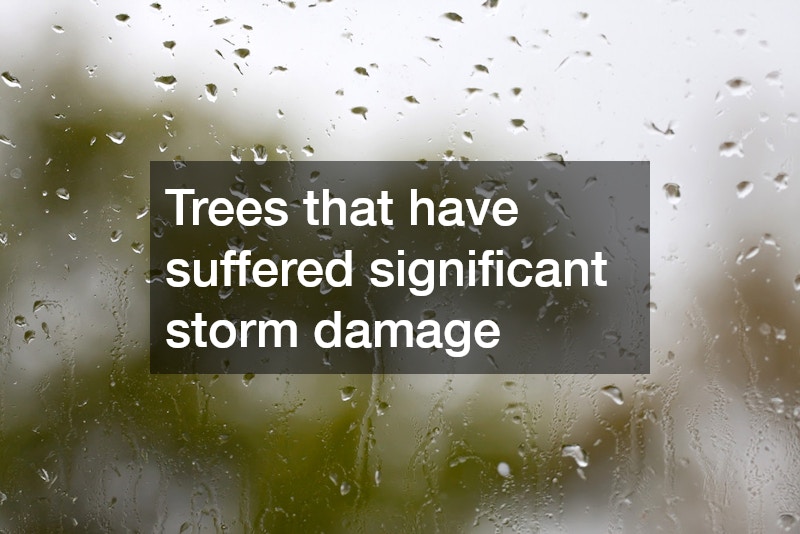Trees are a vital part of any landscape, providing shade, beauty, and environmental benefits. However, not every tree is meant to stay forever. Some trees can become hazardous over time due to disease, structural issues, or environmental stress. Recognizing when a tree needs urgent attention is crucial for the safety of your property and the people around it. Engaging professional tree care services can ensure that problem trees are assessed and removed safely. Here are the top signs that a tree needs to be removed as soon as possible.
1. Dead or Dying Branches
One of the most obvious signs that a tree may need removal is the presence of dead or dying branches. Branches that are brittle, falling off, or lacking leaves can indicate internal decay or disease. While pruning can address minor issues, extensive dead branches may signal structural weakness that compromises the entire tree. Qualified tree care services can assess the severity of the problem and determine whether removal is necessary.
2. Cracks in the Trunk or Major Limbs
Large cracks in the trunk or major limbs of a tree are a serious warning sign. These cracks can weaken the structural integrity of the tree, making it more likely to fall during storms or high winds. Splits or fissures along the trunk or branches often indicate internal decay that cannot be fixed with standard pruning. Immediate evaluation by tree care services is recommended to prevent accidents or property damage.
3. Fungal Growth or Mushrooms at the Base
Fungal growth on a tree or mushrooms appearing at its base are signs of decay. These fungi feed on the wood, breaking down structural components and weakening the tree from the inside out. Ignoring fungal infestations can result in sudden tree collapse. Professional tree care services can identify the type of fungus and determine whether treatment is possible or if removal is the safest option.
4. Leaning or Shifting Trees
A tree that is suddenly leaning or shifting from its normal position may be unstable and at risk of falling. Leaning can be caused by root damage, soil erosion, or internal decay. Even a slight tilt can become dangerous over time, especially during storms. Tree care services can inspect the roots, soil, and overall stability of the tree to decide whether it can be supported or must be removed.
5. Root Damage or Soil Disturbances
Visible damage to a tree’s roots or signs of soil disturbances near the base are red flags. Roots may be cut, decayed, or compromised by construction or erosion, reducing the tree’s ability to anchor itself. If the root system is severely damaged, the tree becomes unstable and may fall unexpectedly. Professional tree care services can evaluate root health and recommend removal if necessary.
6. Extensive Deadwood or Hollow Trunks
A tree with a hollow trunk or extensive deadwood is highly vulnerable to breaking. Hollowing occurs when the inner wood decays, leaving only the outer shell to support the tree’s weight. This can be extremely dangerous, as even a minor windstorm could bring the tree down. Tree care services have the tools and knowledge to assess internal decay and determine whether removal is the safest course of action.
7. Storm Damage or Structural Instability
Trees that have suffered significant storm damage, such as snapped branches, split trunks, or uprooted sections, often require immediate attention. Even if some of the tree appears healthy, structural instability can pose serious risks. Emergency removal by tree care services is often necessary to protect people, buildings, and nearby utilities.
8. Proximity to Buildings or Power Lines
Trees that are growing too close to buildings, fences, or power lines can be dangerous, especially if they show signs of decay or instability. Encroaching branches may damage roofs or walls, while falling limbs can pose electrical hazards. Tree care services can determine whether the tree can be safely pruned or if complete removal is the only safe option.
Trees are beautiful and valuable, but when they show signs of severe damage, disease, or instability, they can become serious hazards. Dead or dying branches, cracks in the trunk, fungal growth, leaning, root damage, hollow trunks, storm damage, and proximity to structures are all strong indicators that a tree may need to be removed immediately. Engaging professional tree care services ensures that the assessment and removal are done safely, protecting your property and the people around it. Recognizing these signs early and taking prompt action can prevent accidents, reduce property damage, and maintain the overall health and safety of your landscape.

